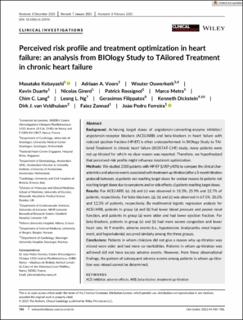| dc.description.abstract | Background
Achieving target doses of angiotensin-converting-enzyme inhibitor/angiotensin-receptor blockers (ACEi/ARB) and beta-blockers in heart failure with reduced ejection fraction (HFrEF) is often underperformed. In BIOlogy Study to TAilored Treatment in chronic heart failure (BIOSTAT-CHF) study, many patients were not up-titrated for which no clear reason was reported. Therefore, we hypothesized that perceived-risk profile might influence treatment optimization.
Methods
We studied 2100 patients with HFrEF (LVEF≤40%) to compare the clinical characteristics and adverse events associated with treatment up-titration (after a 3-month titration protocol) between; a) patients not reaching target doses for unclear reason; b) patients not reaching target doses due to symptoms and/or side effects; c) patients reaching target doses.
Results
For ACEi/ARB, (a), (b) and (c) was observed in 51.3%, 25.9% and 22.7% of patients, respectively. For beta-blockers, (a), (b) and (c) was observed in 67.5%, 20.2% and 12.3% of patients, respectively. By multinomial logistic regression analysis for ACEi/ARB, patients in group (a) and (b) had lower blood pressure and poorer renal function, and patients in group (a) were older and had lower ejection fraction. For beta-blockers, patients in group (a) and (b) had more severe congestion and lower heart rate. At 9 months, adverse events (i.e., hypotension, bradycardia, renal impairment, and hyperkalemia) occurred similarly among the three groups.
Conclusions
Patients in whom clinicians did not give a reason why up-titration was missed were older and had more co-morbidities. Patients in whom up-titration was achieved did not have excess adverse events. However, from these observational findings, the pattern of subsequent adverse events among patients in whom up-titration was missed cannot be determined. | en_US |

